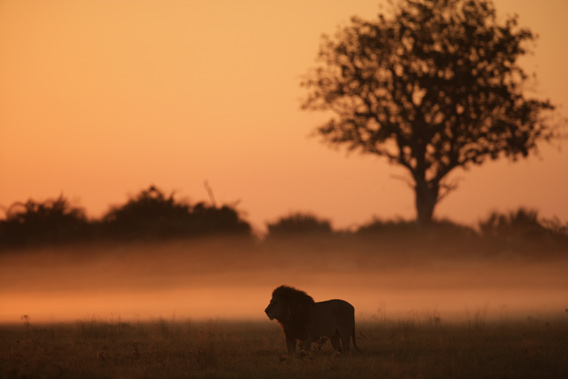
Male lion in the Okavango Delta. © National Geographic Entertainment. Photo by: Beverly Joubert .
The new theatrical film, The Last Lions does not open, as one would expect, with a shot of lions or even an African panorama. Instead the first shot is a view of our planet from space at night. Billions of artificial lights illuminate continent showing just how much humans over the past few thousand years have come to dominate our world. Then comes the lions, but not in person, just in this staggering, and little known, statistic: in the last 50 years we have gone from a population of 450,000 lions to 20,000 today, a 95% decline. While the dramatic story of the The Last Lions follows the perils and tragedies of lion motherhood in one of the world’s last untouched places—the Okavango Delta—this statistic hangs over the film, reminding us that the story we are witnessing is on the verge of extinction.
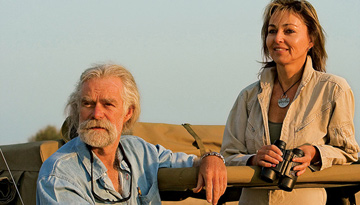 Dereck and Beverly Joubert. Photo by: Jacques Nortier. © National Geographic. |
Most of us have seen at least one documentary on Africa’s lions. But filmed by Dereck and Beverly Joubert, award-winning ‘Explorers-in-Residence’ with National Geographic, The Last Lions feels entirely new. Intimate, surprising, gut-wrenchingly intense, but ultimately hopeful, the film does not romanticize its subjects, but instead grants them the respect they deserve as Africa’s true kings.
In an interview with mongabay.com, the Jouberts discuss their new film, the crisis facing lions, and how everyone can help save Africa’s lions from extinction.
INTERVIEW WITH DERECK AND BEVERLY JOUBERT
Mongabay: Your film follows a mother lion, named Ma di Tau. How did you find this lioness?
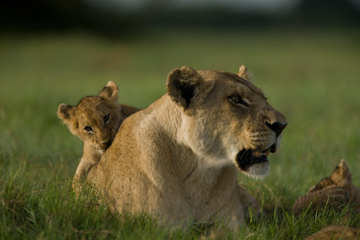 Mau di Tau with cubs. © National Geographic Entertainment. Photo by: Beverly Joubert. |
Dereck and Beverly Joubert: We live in the area, so we are well acquainted with all the lions in the region, virtually by name. We’ve had our camp there for just over 8 years now and studied and followed the lions most of that time on a daily basis. Finding Mau di Tau every day was the challenge, of course, and we weren’t always successful. While it is a fairly small island there seems to be more places to hide than you would imagine.
Mongabay: What was it about Ma di Tau’s story that attracted you?
Dereck and Beverly Joubert: Interesting…actually it was the fact that she had cubs and no one else did on the day really, but there was also something about her. Lions have individual characters and personalities and the more you know them the more you get to realize this and see it in their eyes, the way you or I might see some sparkle in someone’s eye or just like the face. There was a little of that. Oh, I suppose that when we found her she was a lone lioness and that is unusual and we often, in our films, use the unusual to investigate the norm.
Mongabay: The film had the best nocturnal lion scenes I have ever seen. How did you capture these moments?
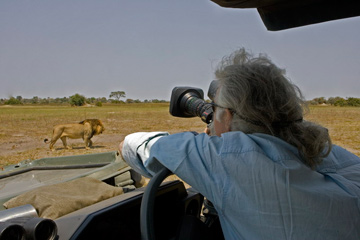 Dereck Joubert filming. © National Geographic Entertainment. Photo by: Beverly Joubert. |
Dereck and Beverly Joubert: Thank you, working at night is tough so we limited the nocturnal scenes to virtually one or two because of the potential of negative influence. Ironically that influence of lights, if used, is less on the lions but on the prey…so we didn’t film or try to film any hunting at all.
What I did was use HD cameras set with a little gain so I could squeeze the most out of the least amount of light. I used a very soft tungsten light, much less than a car headlight, and then I was careful that any lights stayed fixed, so lions could run in and out of it at their will, not mine. In other words I gave them the power to be in the lights or, if it bothered them, to walk out of it, and didn’t chase around and follow them. What we see at night is probably different for everyone on Earth, but depending on the time of night it’s dark sepia just picking up the glow of dawn or inky blue, so we graded for that time of the night.
Mongabay: You caught some intimate moments of mother and cub. How did you get the lions accustomed enough to you to get so close?
Dereck and Beverly Joubert: Oh, just by doing the time. We’ve known that lioness for years now, so she’s really comfortable around us. In fact sometimes she sleeps in the shade of the camera vehicle if the nearest tree shade is too far. We’re always aware not to take that relationship for granted…a 400 lb lion can change her mind about how much she accepts you in an instant! But obviously the cubs had to get to know us. We can only use two advantages or tactics there, one is to just move in and spend day and night with them, parked some way off and moving a little closer each day…and the others is that their mother is so casual about having us around that they pick up cues from her after a while and settle down as well. Our ideal is when they carry on as if we don’t exist.
Mongabay: Were you surprised to see lions hunting in the water?
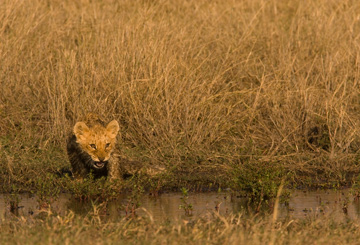 A lion cub tests the water. © National Geographic Entertainment. Photo by: Beverly Joubert. |
Dereck and Beverly Joubert: The first time we saw this, having studied lions in the north of Botswana and in the desert where a rain drop freaks them out, we couldn’t believe what we were seeing. Obviously even the Duba lions don’t enjoy the experience but to get to the island they had to take the plunge and that couldn’t have been easy for any of them.
Mongabay: Without giving anything away there is a lot of loss in the film. How do you think audiences will react to such an unflinching depiction of the harshness of the wild?
Dereck and Beverly Joubert: I think, and hope, that the integrity of the film shines through. Today we are spoon fed so much TV that to see it for real, on a scale that justifies the comment that this is about as real a version of lions and their intimate lives as you will ever see, is what I enjoy about the film. Ironically there is less blood and guts than we’ve shown in our TV documentaries simply because this is not a story about the predatory behavior of these big cats, but more an intimate story of one female’s relationships and struggles to do what lions do, live. Hunting is just a part of that. But we really wanted to show it all in a way that completed cycles, didn’t cut away politely (or falsely), and had no commercial breaks or pop ups and interruptions, for the specific reason of taking people on a journey, not to Africa, not across the river to Duba Island but into the life of a lion, and you only do that, you only get allowed to experience that, without clutter, too much manufacturing of cutting, or clever filmmaking. You do that by leaning forward.
A strange thing happens to people actually; they spend the time with the film and even though narration is minimal, around half way, they are so simpatico with the main character that its like a portal opens and they accept her trials, her successes as victories and they have real tears for her failures. Against that background, a buffalo kill is just what has to happen.
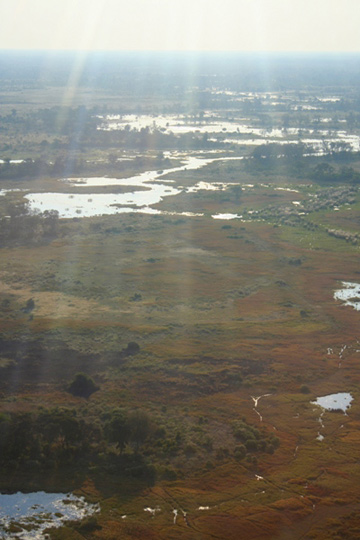 Aerial view of the Okavango Delta. Photo by: Tiffany Roufs. |
Mongabay: Why did you choose the Okavango to tell this story? What makes this wetland special? What makes Okavango lions different from others in Africa?
Dereck and Beverly Joubert: The Okavango, and Botswana in general, is the best managed (and by that I mean best preserved by leaving along and just protecting it) wilderness in Africa in our opinion. Every time we fly over it we feel somehow privileged to even view it from above, let alone live in its intricate detail on the ground. Botswana’s wild places exist because of a great attitude by its people and its government, and the Okavango is the jewel in the crown of this region. Duba Plain, where all of this was filmed, has to be the finest and wildest focal point of the Okavango, so in many ways we chose the best of the best of the best.
THE END OF LIONS
Mongabay: We went from 450,000 lions 50 years ago to 20,000 lions today, over a 95% decline. How did this happen?
Dereck and Beverly Joubert: We happened.
The main issues are:
- We have destroyed wild habitat in Africa, and eroded good range for lions.
- We have systematically slashed and burned back the bush to plant crops or just to fight back the scary things about nature and tame and control and make it ours.
- We have fallen in love with the strongest most noble beasts on Earth, we so admire them that we gauge ourselves against them…so we shoot them and hang them on our walls so we can send a message to others that we are better than the mighty lion.
- We poison them so they don’t hunt our cattle because we are too lazy to look after our livestock and put them in kraals at night.
- We kill them so we can turn them into bones to sell (around $10,000 per lion) to the far East so we can grind them up and turn them into wine or soup and drink it down and feel the tingle of being as sexually robust as a lion (a myth of course…lions have very low sperm counts and sexual organs a fraction of the size of ours in proportion to our body weights).
- We spear them to show potential brides, not how smart we would be about looking after them—sending our kids to school or providing food and a good life—but to show how violent and how we can do things women can’t.
The common word you will have seen is WE.
Mongabay: Given that lions are a hugely popular and charismatic big cat, why do you think the public is so unaware of the precipitous decline undergone by one of our favorite animals?
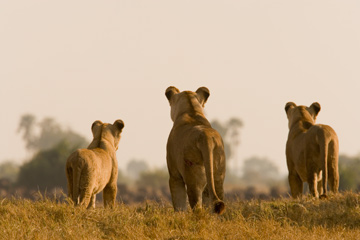 Mau di Tau and cubs. © National Geographic Entertainment. Photo by: Beverly Joubert. |
Dereck and Beverly Joubert: Because they are hugely popular and charismatic. As a society we see lions everywhere and that profusion seeps into our subconscious. Take a drive or walk through your city and I bet you will see a dozen lion icons: flags, statues, lions in zoos, pictures…within a few block. When people go on safari they ask to see lions. Lions inhabit open grassland, so we do see them. Lions are in prides of eight or ten at a time, so we see a lot of them when we do see them. Lions are everywhere, according to what we as a society seem to believe. Mostly I think, what most people believe is that ‘rhinos may disappear or be in trouble, just like the rare Madagascan giant chameleon but lions? Surely someone is taking care of this?’ In some ways the iconic status that the lion enjoys is a handicap.
Mongabay: What role does legal hunting for trophies play in the decimation of lions?
Dereck and Beverly Joubert: It is much a larger impact than we all imagined. Today there are 20,000 lions, maybe at best 30,000, which implies around 4,000 male lions with manes that so attract the safari hunters. That is the resource. So, the US alone imports 550 a year. If you do the math at all, it’s clear that we cannot continue shooting male lions at this rate. The reported US figure is just the tip of the iceberg, of course. If those were the only male lions being killed I’d still be debate that it’s too many, but they’re also being poisoned by poachers, cattle herders, caught in snares, and their habitat is being chopped up! This is jut not going to last.
I also frankly think that it is a sad state when what is clearly declared a ‘sport’ can be defended so vehemently as a right, while the lions’ population suffers and the global community is being faced with a future not decades away, but years away without lions.
Mongabay: How does killing the pride’s male impact the rest of the pride?
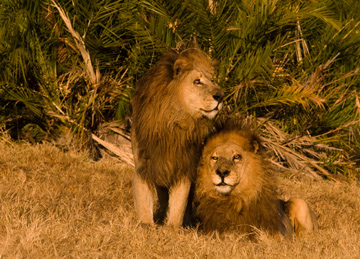 Adult males. © National Geographic Entertainment. Photo by: Beverly Joubert. |
Dereck and Beverly Joubert: When a male lion dies, his companion male (usually two or more males control and defend a pride of females) is left facing threats all alone. Incoming challengers, as in the start of The Last Lions, easily overwhelm the solitary male. So right there, we issue one lion license for hunting and the system suffers a loss of two. When new males take over a pride the first thing they try to do is dominate the female pride (the whole reason for all this) and their entire purpose for that is to mate and spread their genes. Functionally what has to happen to achieve that is to bring the females into estrous, and if they have suckling cubs the males have to kill those first. Old cubs from the dead male don’t make sense genetically either so they kill those. Prides average 8 females. Females average 4 cubs every 2 years. Depending on where we are in that two year cycle of breeding when the one male is hunted, and new males arrive, we could see 24 cubs killed, one older male (with a license attached) and another older male, and usually one female like Ma di Tau who resists and doesn’t make it. Death toll: round it down to 25. Fees to government: for one male.
Mongabay: How does the loss of lions—as top predators—impact the overall African ecosystem?
Dereck and Beverly Joubert: We have to make one basic assumption…that everything in nature is there for a reason or that it at least plays an interactive role with the environment and other species. However beyond that, the top predators of the world are drivers of the environment around them. Take sharks out of the seas and you see the collapse of ocean and reef systems. If we take Africa’s top predator out, we start seeing a blooming of other medium sized prey, that takes it toll on medium and resident prey. We see stagnation of movement and, in some cases, the stopping of whole migrations when the reason to move (lions) is eliminated. A stable and stagnant savanna ecosystem is a dying one and we very shortly see collapse, as we have from Ghana to parts of Southern Africa. We’ve seen the opposite in Yellowstone with the reintroduction of wolves, and the revitalizing of the system.
LION CONSERVATION
Mongabay: Given how far lions have fallen in just half a century, how do we save them?
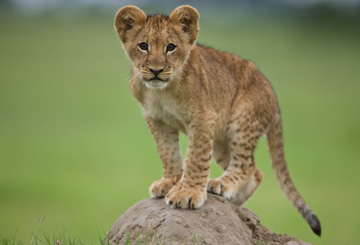 Lion cub. © National Geographic Entertainment. Photo by: Beverly Joubert. |
Dereck and Beverly Joubert: First of all it’s a mindset change. We can’t do this alone; we’d never succeed. But if the entire global society realizes that we have a problem that is 9/10th of the way, right there. It’s a bit like any addiction: the hardest or first step is to actually acknowledge that you have an addiction. So we, as a species, are addicted to some activities that harm predators, so that we harm the environment and we harm ourselves. We all need to understand this.
On the ground we need to secure land. We need to protect it. We need to stop the market and desire to kill lions. The truth is this isn’t that hard. It will cost money: $50 million (which is the cost of 5 minutes of the Iraq war right now) will secure the majority of the lions we have left today.
We need to double that recent number in 10 years or we will lose them.
Mongabay: What is the Big Cat Initiative (BCI)? How will this program work to help Africa’s lions?
Dereck and Beverly Joubert: BCI is an emergency effort set up to tackle this issue right now. It aims to highlight, put action in place, and to stop the lions’ slide in 5 years and to reverse the trend in 10.
We’ve got projects in 5 countries in Africa and we’re scouring resources for out of the box solutions. The one thing we do know for sure is that whatever we’ve been doing for 40 years has not been working. We are applying new solutions, new ideas, and new people to do this. No conservation today will work without the help of communities in Africa. These have been our first efforts.
Mongabay: What are a few things people can do to help protect Africa’s ‘king of the beasts’?
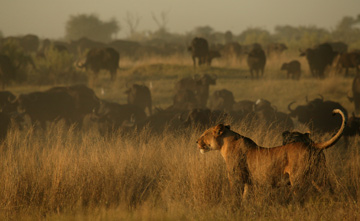 Mau di Tau surveys African buffalo herd. © National Geographic Entertainment. Photo by: Beverly Joubert. |
Dereck and Beverly Joubert: We have to stop being passengers or spectators in life and do something. So, some people may be able to donate money, others will be interacting with hunters, poachers, traders in lion bones, skins…if each person is knowledgeable and can convince another to back off from the trade or overuse (or abuse) then all this stops.
Others will be able to lobby to get lions on the Endangered Species protection list. Look at the numbers. Lions are not classified as Endangered. We need to lobby for change. Support bills like the wild dog and cat bill, support or weigh in with representatives who will take the message loud and clear to the highest levels that it is unacceptable to see these animals disappear.
CITES is a convention that controls the trade of animals internationally. Lions have no protected status there. Motions need to be made by governments. The US needs to support this.
Get involved. We need an army of supporters who understand that we have to do the right thing.
Lastly and I don’t want this to be a punt for the film but if you watch The Last Lions or go on www.causeanuproar.org
you will be able to find out all about this and ways to be heard. Also go to www.ngsbigcats.org. At the end of the film we ask people to SMS the word LIONS to 5055 to donate $10. Everything we raise is being matched and all the profits from the film are being donated back to big cats.
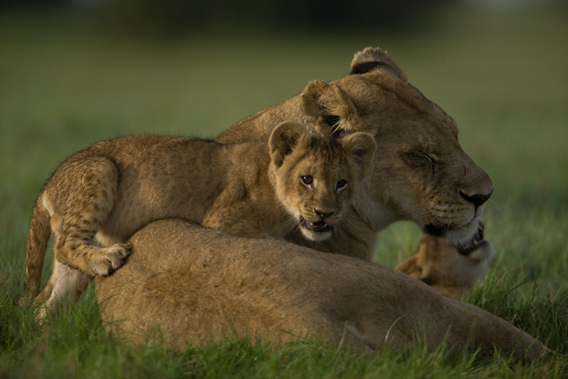
Mau di Tau with cubs. © National Geographic Entertainment. Photo by: Beverly Joubert.
Related articles
Lion population in Kenya could disappear in 10 to 20 years
(08/20/2009) The Kenyan Wildlife Service recently announced that massive declines in lion population may lead to their disappearence from the region within less than 2 decades. Kenya currently has an estimated 2000 lions, but is losing the large cats at a rate of around 100 each year.
Why top predators matter: an in-depth look at new research

Africa’s lions are disappearing
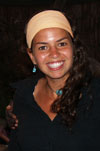 (03/25/2008) The lion is Africa’s best known carnivore. Once widely abundant across the continent, recent surveys show that lion populations have plunged from over 100,000 individuals to around 23,000 over the past century. The reason? Lions are poisoned, shot, and speared by locals who see them as a threat to livestock. While lion populations in protected areas remain relatively healthy, conservationists say that without urgent measures, lions may disappear completely from unprotected areas. The Kilimanjaro Lion conservation Project is working to avoid this fate by developing practical measures to encourage coexistence between people, livestock and predators. Key to the effort is reducing livestock losses to lions. Leela Hazzah, a field researcher with the project, says the “Lion Guardians” program at Mbirikani Ranch in Kenya has proved remarkably successful: not a single lion has been killed since its inception in November 2006. The program employs Maasai warriors to monitor lions and help local communities prevent attacks on livestock.
(03/25/2008) The lion is Africa’s best known carnivore. Once widely abundant across the continent, recent surveys show that lion populations have plunged from over 100,000 individuals to around 23,000 over the past century. The reason? Lions are poisoned, shot, and speared by locals who see them as a threat to livestock. While lion populations in protected areas remain relatively healthy, conservationists say that without urgent measures, lions may disappear completely from unprotected areas. The Kilimanjaro Lion conservation Project is working to avoid this fate by developing practical measures to encourage coexistence between people, livestock and predators. Key to the effort is reducing livestock losses to lions. Leela Hazzah, a field researcher with the project, says the “Lion Guardians” program at Mbirikani Ranch in Kenya has proved remarkably successful: not a single lion has been killed since its inception in November 2006. The program employs Maasai warriors to monitor lions and help local communities prevent attacks on livestock.
Lion populations plummet in Uganda’s parks
(08/19/2010) Lion populations across Uganda’s park system have declined 40 percent in less than a decade, according to the Wildlife Conservation Society (WCS).